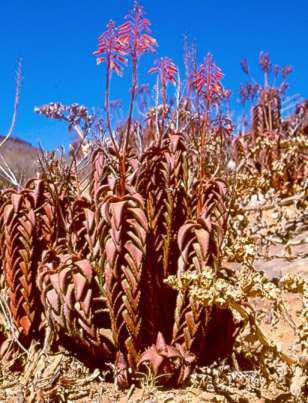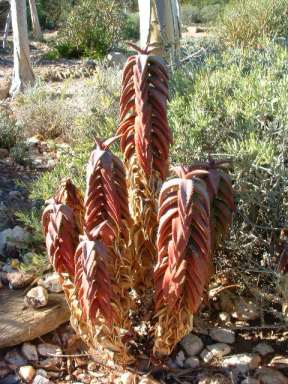Aloe pearsonii
Aloe pearsonii Schönland
Family: Asphodelaceae
Common names: Pearson's aloe
Introduction
Aloe pearsonii is a very distinctive aloe with its almost perfectly arranged vertical rows of leaves that cover the slender stems like a long narrow skirt. In its natural habitat, many colonies may cover and colour the landscape with its reddish leaves.

Description
Description
They are densely branched and erect plants with their lower stem area often covered with dead, persistent leaves and the upper area with living leaves. Branching may take place from the base of the stem or higher up.
The densely arranged leaves are elongate-triangular, mainly downward curving and arranged in four ranks. The dull bluish-green leaves often turn red, especially in times of drought. The backward curving leaves give the rosettes a distinctive appearance that is unmistakable of this species.

The inflorescence is often branched low down into two or three head-shaped racemes. Flower colour is varied from red, yellow and red-yellow. Aloe pearsonii is summer flowering (Dec.-Jan.). As with other aloes, the seeds are typically winged, small, up to 4 mm, and produced in abundance inside the fruit capsules that split into three when ripe. Seeds ripen quickly as a result of the extreme heat, normally around February to March.
Conservation Status
Status
Aloe pearsonii is regarded as endangered as a result of illegal collecting and of habitat loss due to mining activities and overgrazing (Van Wyk & Smith 2003). In its habitat, however, it is still found in abundance, often seen covering slopes and foothills.
Distribution and habitat
Distribution description
Aloe pearsonii is highly localized and thus an endemic of the Richtersveld around Helskloof and the adjacent mountains across the Gariep (Orange) River in Namibia. It occurs at altitudes of about 300 to 1500 m (950-5000 ft). At Helskloof, dense colonies dominate the landscape and colour all the mountain slopes (Williamson 2000).
Aloe pearsonii grows in a variety of soils which are mainly granite, sandstone and shale derived. The many different formations of the Gariep Super Group comprise rock such as conglomerate, sandstone, quartzite, shale, limestone, dolomite, schist, lava, volcanic breccia and tuff (Van Wyk & Smith 2001). The soils in which A. pearsonii grows are usually sandy, shallow and stony, but clayey soils do occur.
Aloe pearsonii seems to prefer slopes, hills and plateaus of the arid landscapes in the Richtersveld and surrounds. It is most regularly seen in exposed situations but colonies do occur in valleys with deep ravines, where they are more blue-green as a result of morning and afternoon shady conditions.
Derivation of name and historical aspects
History
The genus name Aloe is derived from the Arabic, alloch, and translated as allal in Greek and Hebrew, literally meaning bitter or bitter sap, which is descriptive of aloe sap. The species epithet pearsonii was given in honour of the first director of Kirstenbosch Botanic Garden, Prof. Harold H.W. Pearson, who collected the plants in 1910.
Aloe pearsonii is probably the least typical of the creeping aloes but it fits very comfortably in the group as it has the same rather unique combination of chemical compounds in the leaves as is present in all five related species: A. meyeri, A. distans, A. dabenorisana, A. perfoliata and A. arenicola (Van Wyk & Smith 2003). Plants can grow as quite large specimens or much-branched shrubs of up to x 2 m or more.
All species of creeping aloes flower in the dry summer months and occur in the Northern, Western and Eastern Cape Provinces of South Africa. It is noteworthy that five of the six creeping aloes are threatened in one way or another. The genus Aloe has recently undergone revision and some of the names listed above may have changed.
Ecology
Ecology
Aloe pearsonii produces nectar and is pollinated by sugarbirds as well as winged and crawling insects such as ants which are small enough to enter the flower tube in which the nectar is stored. After fertilization, the fruit, which is a capsule, grows quickly and splits into three parts at the end of the summer. The seeds are small, up to 4 mm, and slightly winged enabling them to be dispersed by the wind. Pieces of the stem that break off may also root when conditions are ideal.
The plant in itself is very tough and can often survive for several seasons without water, at which point the leaves turn reddish, a sign generally associated with stress. Groups of Aloe pearsonii are often found in places inhabited by hyraxes, otherwise known as rock dassies (Procavia capensis). The droppings of these cuddly looking mammals, whose closest relatives are elephants, can easily be seen in close proximity to colonies of Aloe pearsonii and A. gariepensis (Gariep River aloe). It is a known fact that the roots and stems of these plants serve as a source of moisture or food.
Uses
Use
Klipspringer ( Oreotragus oreotragus ) and rock dassies occasionally eat the roots and stems of the plant.
While there are no records of this particular species as a food source for humans, the yellow bitter sap in the leaves, as with other aloes, can be used as a laxative and to heal wounds.
The horticultural value of Aloe pearsonii in gardens goes without saying, although this particular species has proven difficult in cultivation.

Growing Aloe pearsonii
Grow
It is a well-known and established plant in gardens of keen succulent collectors. For smaller gardens the plants can be used in deep plant boxes or pots. The ideal garden planting is a group of about 20 plants. Again it must be emphasized that Aloe pearsonii struggles away from its natural habitat: to be grown successfully it needs hot weather. For optimal flowering, remember to plant it in full sun. Raised rock gardens that allow good drainage are the best situations for these plants. Alternatively, plants can be grown in containers in glasshouses during the winter and brought out in the summer.
Growing Aloe pearsonii is not as easy to grow as the other creeping aloes. Although it is possible to grow these plants from cuttings and offsets, it takes a very long time to grow new roots and the dangers of over-watering and disease is always present.
The best results are achieved from seeds. Seeds must be sown as fresh as possible. When kept too long they are parasitized by small crawling insects. The best time for sowing is in the late summer before winter sets in, around February to May. Use coarse river sand and cover seeds lightly, then keep moist. It is advisable to treat seeds with a long-lasting fungicide, as seedlings are prone to damping off, a fungus that eventually kills the young plants. Simply shake seeds in a container with some fungicide.
After germination, when plants are about 20-30 mm high, transplant them using a sandy-loam medium and feed with organic-based fertilizer at least once a month to ensure healthy growth. If you have a garden with clay soil, use some agricultural lime and bone meal to break up and nourish the soil.
Mature plants in cultivation may at times be subjected to attack from scale insects and aphids. For scale insects, an oil-based solution can be used, even soap water has proven effective, and the best results are obtained by physically removing the scale, using a cloth. Contact insecticides usually work well but in heavy infestations a systemic application may be necessary. All known garden pests can be kept to a minimum by simply ensuring optimal growing conditions and healthy plants.
Companion plants to Aloe pearsonii include A. melanacantha, A. claviflora, A. falcata, A. gariepensis, A. dichotoma, A. dichotoma subsp. ramosissima and A. arenicola.. Other plants to consider are Lampranthus aureus, L. multiradiatus, L. reptans, Pelargonium echinatum, P. xerophytum, P. spinosum, P. sericifolia, P. crithmifolium, Tripteris oppositifolium, Stoeberia arborea, Gazania krebsiana, Hermannia saccifera and Oscularia deltoides. Larger succulents such as Tylecodon paniculatus, Cyphostemma juttea and Cotyledon orbiculata are also good choices.
References
- Court, D. 1981. Succulent flora of southern Africa. Balkema, Cape Town.
- Cowling, R. & Pierce, S. 1999. Namaqualand, a succulent desert. Fernwood Press, Cape Town.
- Germhuizen, G. & Meyer, N.L. (eds). 2003. Plants of southern Africa : an annotated checklist. Strelitzia 14. National Botanical Institute, Pretoria.
- Jackson, W.P.U. 1990. Origins and meanings of South African plant genera. University of Cape Town Ecolab.
- Leistner, O.A. 2005. Seed plants of southern tropical Africa : families and genera. Southern African Botanical Diversity Network Report No. 26. SABONET, Pretoria.
- Nichols, G. 2005. Growing rare plants, a practical handbook on propagating the treatened plants of southern Africa. Southern African Botanical Diversity Network Report No. 36. SABONET, Pretoria.
- Smith, C.A. 1966. Common names of South African plants. Memoirs of the Botanical Survey of South Africa No. 35.
- Stearn, W.T. 2003. Stearn's dictionary of plant names for the gardener. Cassel, UK.
- Van Jaarsveld, E., Van Wyk, B-E. & Smith, G.F. 2000. Succulents of South Africa. Tafelberg, Cape Town.
- Van Wyk, A.E. & Smith, G.F. 2001. Regions of floristic endemism. Umdaus Press, Hatfield, Pretoria.
- Van Wyk, B-E. & Gericke, N. 2000. People's plants. A guide to useful plants of southern Africa. Briza Publications, Pretoria.
- Van Wyk, B-E. & Smith, G.F. 1996. Guide to aloes of South Africa. Briza Publications, Pretoria.
- Williamson, G. 2000. Richtersveld, the enchanted wilderness. Umdaus Press, Hatfield, Pretoria.
Credits
Werner Voigt
Kirstenbosch NBG
November 2007
Plant Attributes:
Plant Type: Succulent
SA Distribution: Northern Cape
Soil type: Sandy, Clay
Flowering season: Early Summer
PH: Alkaline
Flower colour: Red, Yellow
Aspect: Full Sun
Gardening skill: Challenging
Special Features:
Horticultural zones








Rate this article
Article well written and informative
Rate this plant
Is this an interesting plant?
Login to add your Comment
Back to topNot registered yet? Click here to register.